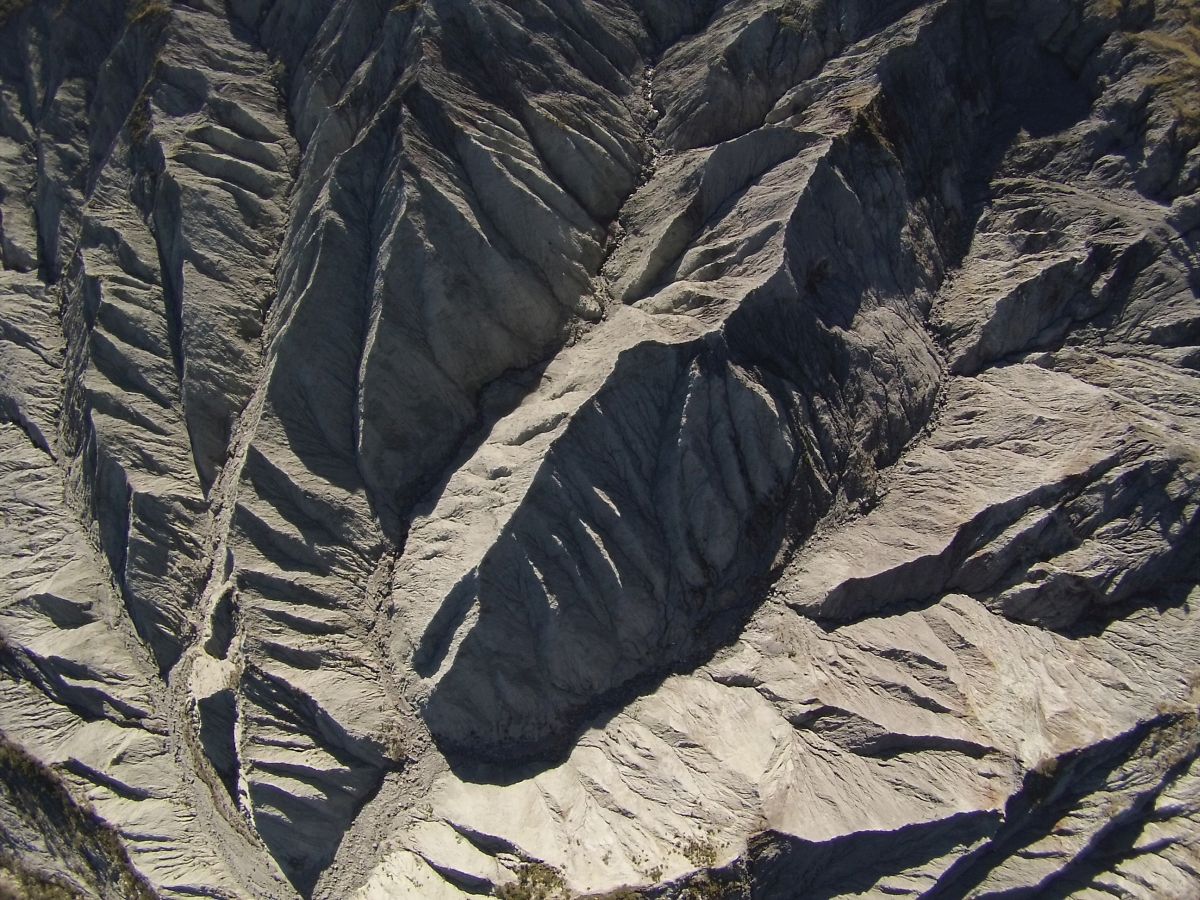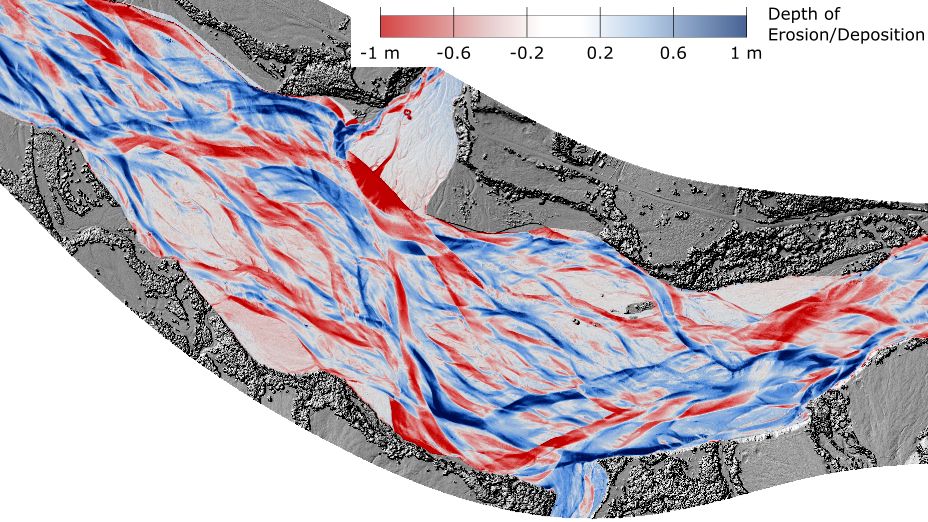Expertise and Focus
My research is focused primarily on the river sediment budget framework; understanding how the nature and rates of sediment contribution from various sources drives system function and river morphodynamics. I am particularly interested in the nature of sedimentary disturbance, such as landslide deliveries to river systems, on the smaller scale, or glaciation on a much larger one. Pushing a system to its limits tells us a great deal about the nature of river resilience, its adaption to change in governing variables, and the nature of system recovery. Learning from this can help in managing human impacts on river systems.
Key Publications and Presentations
Tunnicliffe, J., and P. Ashmore. 2024. “Coevolution of morphology, flow conditions and pulsed transport in a laboratory-scale braided river: Numerical simulations.” River Flow 2022 (2024): 414.
Tunnicliffe, J., Howarth, J., Massey, C. 2024. Controls on fluvial sediment evacuation following an earthquake-triggered landslide: observations from LiDAR timeseries. Science Advances 10.1126/sciadv.adi5560.
Delong, M. D., Thoms, M. C., Fuller, I. C., Tunnicliffe, J., Phillips, J., & Cossart, R. 2024. Chapter 4 Understanding changing riverine landscapes: instability, thresholds, and tipping points. In Resilience and Riverine Landscapes (pp. 69-95). Elsevier. doi:10.1016/b978-0-323-91716-2.00029-7.
Tunnicliffe, J., Walker, K., Pohatu, P., Warmenhoven, T., Murphy, P., Cave, M., Baucke, D. & Brierley, G. 2023. Catchment-scale monitoring of river change to support a gravel management plan, Waiapu River, Aotearoa New Zealand. Gravel Bed Rivers IX: : Processes, resilience and management in a changing environment. Villaricca, Chile. Jan 9-13, 2023.
Brierley, G. J., Hikuroa, D., Fuller, I. C., Tunnicliffe, J., Allen, K., Brasington, J., Measures, R. 2023. Reanimating the strangled rivers of Aotearoa New Zealand. Wiley Interdisciplinary Reviews: Water, 10(2), e1624.
Cook, M., Brook, M.S., Hamling, I.J., Cave, M., Tunnicliffe, J., Holley, R. 2023. Investigating slow-moving shallow soil landslides using Sentinel-1 InSAR data in Gisborne, New Zealand. Landslides. 10.1007/s10346-022-01982-9
Wolter, A., Gasston, C., Morgenstern, R., Farr, J., Rosser, B., Massey, C., … & Tunnicliffe, J. 2022. The Hapuku Rock Avalanche: Breaching and evolution of the landslide dam and outflow channel revealed using high spatiotemporal resolution datasets. Frontiers in Earth Science, 1280. 10.3389/feart.2022.938068
Ravazzolo, D., Spreitzer, G., Tunnicliffe, J., & Friedrich, H. 2022. The effect of large wood accumulations with rootwads on local geomorphic changes. Water Resources Research, e2021WR031403. 10.1029/2021WR031403
Spreitzer, G., Ravazzolo, D., Tunnicliffe, J., & Friedrich, H. 2022. Measuring the impact: new insights into flood-borne large wood collisions with river structures using an isolated sensor-unit. Natural Hazards, 1-23. 10.1007/s11069-022-05354-3
van der Sluijs, J., Kokelj, S. V., & Tunnicliffe, J. F. 2022. Allometric scaling of retrogressive thaw slumps. The Cryosphere, 1-30. 10.5194/tc-2022-149
Wheeler, N., Pingram, M., David, B., Marson, W., Tunnicliffe, J., & Brierley, G. 2022. River adjustments, geomorphic sensitivity and management implications in the Waipā catchment, Aotearoa New Zealand. Geomorphology, 410, 108263. 10.1016/j.geomorph.2022.108263
Brierley, G.J., Tunnicliffe, J., Bizzi, S., Lee, F., Perry, G., Peoppl, R., Fryirs, K. 2022. Quantifying sediment (dis)connectivity in the modelling of river systems (Book Chapter). Treatise on Geomorphology, 2nd Ed. Shroder, J. Ed. Elsevier Publications. 6892 pp. 10.1016/b978-0-12-818234-5.00161-9
Friedrich, H., Ravazzolo, D., Ruiz-Villanueva, V., Schalko, I., Spreitzer, G., Tunnicliffe, J., Weitbrecht, V. 2021. Physical modelling of large wood (LW) processes relevant for river management: Perspectives from New Zealand and Switzerland. Earth Surface Processes and Landforms. doi:10.1002/esp.5181
Hicks, D. M., Baynes, E. R. C., Measures, R., Stecca, G., Tunnicliffe, J., & Friedrich, H. 2021. Morphodynamic research challenges for braided river environments: Lessons from the iconic case of New Zealand. Earth Surface Processes and Landforms, 46(1), 188-204. doi:10.1002/esp.5014
Kokelj, S., Kokoszka, J., van der Sluijs, J., Tunnicliffe, J., Rudy, A., Shakil, S., Tank, S., and Zolkos, S. 2021 Thaw-driven mass wasting couples permafrost slopes with downstream systems and effects propagate through Arctic drainage networks. Crysophere. doi:10.5194/tc-2020-218
Brierley, G., Tadaki, M., Hikuroa, D., Blue, B., Šunde, C., Tunnicliffe, J., and Salmond, A. 2018. A geomorphic perspective on the rights of the river in Aotearoa New Zealand. River Research and Applications. doi:10.1002/rra.3343
Poeppl, R. E., Fryirs, K. A., Tunnicliffe, J., & Brierley, G. J. 2020. Managing sediment (dis)connectivity in fluvial systems.. The Science of the Total Environment, 736, 139627. doi:10.1016/j.scitotenv.139627
Spreitzer, G., Tunnicliffe, J., & Friedrich, H. 2020. Porosity and volume assessments of large wood (LW) accumulations. Geomorphology, 358, 107122. doi:10.1016/j.geomorph.2020.107122
Fuller, I. C., Strohmaier, F., McColl, S. T., Tunnicliffe, J., & Marden, M. 2020. Badass gully morphodynamics and sediment generation in Waipaoa Catchment, New Zealand. Earth Surface Processes and Landforms, 45(15), 3917-3930. doi:10.1002/esp.5010
Tunnicliffe, J., Howarth, J., Upton, P. and Massey, C. 2018. Landslide-induced aggradation dynamics in the fluvial system: A high-resolution topographic record of river change in the wake of the Nov 2016 Kaikōura Earthquake. American Geophysical Union Meeting. Dec 10-15, 2018, Washington DC.
Tunnicliffe, J., Fuller, I., Eaton, B., Peacock, D., and Marden, M. 2018. Reconstructing the sediment dynamics of an overloaded gravel bed river, East Cape, N.Z. Binghamton Symposium on Geomorphology. October 5-7, 2018. Syracuse, NY.
van der Sluijs, J., Kokelj, S.V., Fraser, R.H., Tunnicliffe, J., and Lacelle, D. 2018. Permafrost dynamics and infrastructure impacts revealed by UAV-derived terrain information. Remote Sensing (10, 954). doi:10.3390/rs10060954.
Chim, K., Tunnicliffe, J., Shamseldin, A., & Ota, T. 2019. Land Use Change Detection and Prediction in Upper Siem Reap River, Cambodia. Hydrology, 6(3), 23 pages. doi:10.3390/hydrology6030064
Leenman, A., and Tunnicliffe, J. 2020. Tributary‐junction fans as buffers in the sediment cascade: a multi‐decadal study. Earth Surface Processes and Landforms. doi:10.1002/esp.4717.
Brierley, G., Tadaki, M., Hikuroa, D., Blue, B., Šunde, C., Tunnicliffe, J., and Salmond, A. 2018. A geomorphic perspective on the rights of the river in Aotearoa New Zealand. River Research and Applications. doi:10.1002/rra.3343.
van der Sluijs, J., Kokelj, S.V., Fraser, R.H., Tunnicliffe, J., and Lacelle, D. 2018. Permafrost dynamics and infrastructure impacts revealed by UAV-derived terrain information. Remote Sensing 10, 954. doi:10.3390/rs10060954
Leenman, A., and Tunnicliffe, J. (2018). Genesis of a major gully mass-wasting complex. Geological Society of America Bulletin, 129. doi:10.1016/j.geomorph.2017.10.029
Tunnicliffe, J., Brierley, G. J., Fuller, I. C., Leenman, A., Marden, M., & Peacock, D. (2018). Reaction and relaxation in a coarse-grained fluvial system following catchment-wide disturbance. Geomorphology. doi:10.1016/j.geomorph.2017.11.006
Walley, Y., Tunnicliffe, J., & Brierley, G. (2017). The influence of network structure upon sediment routing in two disturbed catchments, East Cape, New Zealand. Geomorphology. doi:10.1016/j.geomorph.2017.10.029
Tunnicliffe, J. and Brierley, G. (2016). Sediment Regime and River Morphodynamics. Oxford Bibliographies in Geography, http://www.oxfordbibliographies.com. doi:10.1093/obo/9780199363445-0061.
Brierley, G. and Tunnicliffe, J. (2016). Sediment Budgets and Sediment Delivery Ratios in River Systems. Oxford Bibliographies in Geography, http://www.oxfordbibliographies.com. doi:10.1093/obo/9780199363445-0058.
Kokelj, S.V., Lantz, T.C., Tunnicliffe, J., Segal, R., & Lacelle, D. (2016). Climate-driven thaw of permafrost preserved glacial landscapes, northwestern Canada. Geology. doi: 10.1130/G38626.1
Tunnicliffe, J., & Church, M. (2015). A 1-D morphodynamic model of postglacial valley incision. Journal of Geophysical Research F: Earth Surface, 120(11), 2253-2279. doi:10.1002/2014JF003370
Kokelj, S. V., Tunnicliffe, J., Lacelle, D., Lantz, T. C., Chin, K. S., & Fraser, R. (2015). Increased precipitation drives mega slump development and destabilization of ice-rich permafrost terrain, northwestern Canada. Global and Planetary Change, 129, 56-68. doi:10.1016/j.gloplacha.2015.02.008
Forthcoming
Tunnicliffe, J., Howarth, J., Massey, C. The transformation of a steepland river valley following an earthquake-triggered landslide near Kaikōura, NZ.

